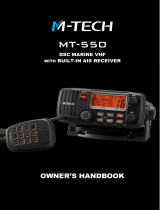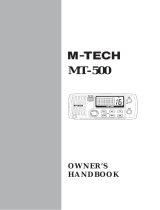
20 |
General Information | RS40/RS40-B User Guide
2. CREATE NEW MOB: to cancel current MOB navigation and create a
new Man-Over-Board (MOB) waypoint at the current location.
Or, short press X to close the pop up and resume current MOB
navigation.
¼ Note: Long press TRI and SCAN keys on the wireless handset to set a
MOB waypoint.
9. Weather key (Radio and wireless handset)
Short press (US/CAN country mode): press to hear the most recently
selected NOAA/Canadian weather station.
For non US/CAN country modes, changes channel to user
programmed choice. When in ATIS mode, will select CH10.
Long press (non US/CAN country mode): to store current channel as
the weather, local harbor or preferred channel.
10. SCAN / ZOOM- (Radio and wireless handset)
• Normal radio mode:
Short press to enter ALL SCAN mode.
ALL SCAN sequentially scans all channels for activity.
When a signal is received, scanning stops at that channel and the
BUSY icon appears on the screen. If the signal ceases for more than 5
seconds, the scan automatically resumes.
Turn the channel knob to temporarily skip over (lock out) a busy
channel and resume the scan. The direction turned determines if
the scan goes up or down the channel numbers (ie ‘forward’ or
‘reverse’). If it is still busy when the scan completes a full cycle, it will
stop again at this channel. Note that it is not possible to skip over the
priority channel.
Press ENT to permanently skip over the channel. The SKIP icon will
show on the LCD for this channel.
To cancel a skipped channel, select the channel while in normal
mode (non-scan mode) then press the ENT key - the SKIP icon will
disappear. Repowering the radio also restores all skipped channels.
Press SCAN or X while scanning is active to stop at the current
channel and return to normal operation.
Long press SCAN from normal operation to enter the SCAN menu.
• AIS mode:
Short press to increase (zoom out) the scale of the AIS plotter out
one range at a time. The scales available are: 1, 2, 4, 8, 16, 32 nm.
11. TRI / ZOOM+ (Radio and wireless handset)
• Normal radio mode:
Short press to start DUAL WATCH or TRI WATCH (if ‘watch’ channel
set).
Long press to set the current channel as the watch channel.






















